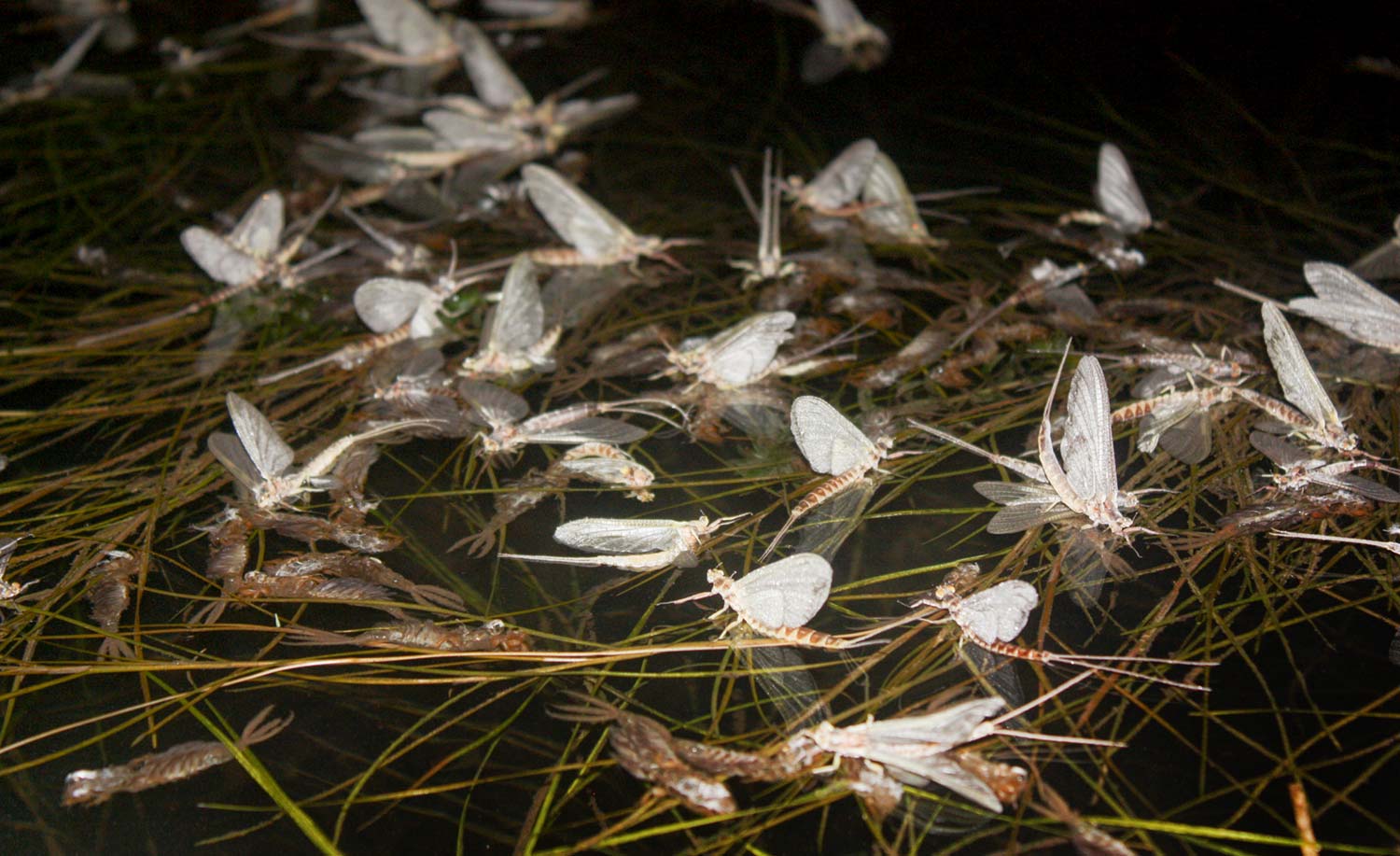
Photos by Jason Tucker and Alex Cerveniak
By Jason Tucker
I listened to a fishing podcast the other day in which both the hosts discussed the famous Hexagenia mayfly hatch.
Despite admitting that neither of them had ever fished the hatch, both opined that the Hex hatch was probably overrated. Yeah it has a reputation for big bugs, big hatches and big fish, but experiencing it must be akin to sighting a cougar east of the Mississippi.
If you haven’t experienced a good Hex hatch on a trout stream in the upper Midwest and Great Lakes region, perhaps you’re wondering if it really lives up to the hype. Is it worth traveling to experience? Should it be on my bucket list? Is it more hype than reality? How do I get in on the action without wasting time and money?
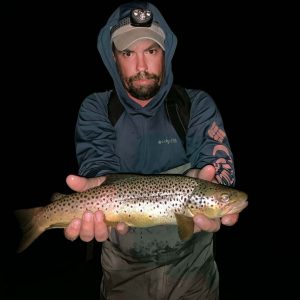 I’m here to tell you that experiencing the Hexagenia limbata hatch is definitely worth it, and I’m going to give you the knowledge you need to be successful. It is worth seeing even if you don’t fish. It’s one of those rare experiences in which you experience animal numbers that are normally associated with the Serengeti or caribou in the Canadian tundra, or mass bird migrations. Just because they are insects makes it no less magical; in fact it is more so if you are a fly angler. There is a beauty and grace to the bugs themselves, and watching a river of bugs flying upstream to mate, or a swarm so dense you can’t see through it, or their dance over the water as the females fly upward and the males pursue is all magical in itself, a privilege for anyone to witness.
I’m here to tell you that experiencing the Hexagenia limbata hatch is definitely worth it, and I’m going to give you the knowledge you need to be successful. It is worth seeing even if you don’t fish. It’s one of those rare experiences in which you experience animal numbers that are normally associated with the Serengeti or caribou in the Canadian tundra, or mass bird migrations. Just because they are insects makes it no less magical; in fact it is more so if you are a fly angler. There is a beauty and grace to the bugs themselves, and watching a river of bugs flying upstream to mate, or a swarm so dense you can’t see through it, or their dance over the water as the females fly upward and the males pursue is all magical in itself, a privilege for anyone to witness.
Hexagenia limbata mayflies occur across North America and I’ve experienced them everywhere from Labrador to Ontario to Washington State (where we got in on a stellar lake hatch) to the Deep South where I live, but the best place to fish this hatch is probably Northern Michigan. Wisconsin, Pennsylvania and New York (and I’m sure other Northeast states) all get hatches, but no place, not even Michigan’s Upper Peninsula, has a reputation for the Hex hatch like Northern Michigan, starting with Lake Michigan tributaries running up the west side of the state, up to its zenith on the Au Sable and Manistee rivers, and north to the tip of the mitt as we call it.
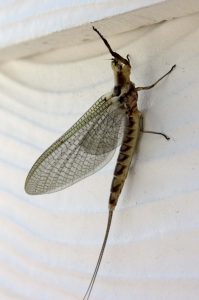 The first thing you need to know about Hex mayflies and brown drakes is that they’re more of a lake dwelling insect than a stream dwelling insect.
The first thing you need to know about Hex mayflies and brown drakes is that they’re more of a lake dwelling insect than a stream dwelling insect.
The most massive hatches occur on lakes like Lake St. Clair, Lake Erie and even the Mississippi river, all of which throw off such dense clouds of mating insects each season that they show up on weather radar. Around Lake St. Clair I’ve seen “drifts” of them piled up a couple feet deep smelling like rotten fish. They pile up so deep under street lights that they cause auto accidents because they make the roads slick. Unlike much of Wisconsin, or Michigan’s UP, which have limestone, sand or granite bedrock, Northern Michigan is glacial moraine, a giant pile of gravel, sand, clay and marl left by Ice Age glaciers. Hex and brown drake mayfly nymphs are burrowing insects that require muck and marl to burrow in. The bottoms and margins of the inland and Great lakes in this area are the perfect habitat. Trout streams with a bedrock bottom, or that are swift freestone streams with little muck on the margins do not support Hex hatches worth mentioning. It is streams that have an overlap of the two habitats- cold clean water for trout, and muck and marl bottom or margins typically that flow into lakes that host large numbers of these flies that get the best hatches, and in no place do those factors seem to converge more than in Northern Michigan.
This is why Michigan’s Au Sable river is so famous for its Hex hatch. It’s basically one long flowing lake, with wide mucky margins, but it regularly gets infusions of very cold water from tributary streams and springs that keep it comfortable for trout. By July 4 many stretches become unfishable due to high water temps. It also flows into three reservoirs along its length that contribute to the hatches on the flowing sections. It is this convergence of habitats and factors that make it a Hex factory.
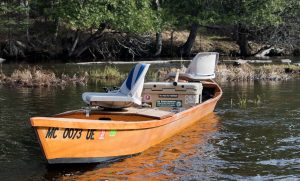 But it’s not just the Au Sable that gets great hatches. The nearby Manistee gets fantastic Hex hatches, and has lots of access and water suited to both wading and drift boats. The Pere Marquette river is probably under-rated for its Hex hatch, as is the Rifle. Even the Muskegon gets a good one. Throw in dozens of smaller, lesser known streams throughout the state and your options are almost endless, and they all host giant trout that come out to feed on the big bugs. So why do you hear such mixed messages about the Hex hatch?
But it’s not just the Au Sable that gets great hatches. The nearby Manistee gets fantastic Hex hatches, and has lots of access and water suited to both wading and drift boats. The Pere Marquette river is probably under-rated for its Hex hatch, as is the Rifle. Even the Muskegon gets a good one. Throw in dozens of smaller, lesser known streams throughout the state and your options are almost endless, and they all host giant trout that come out to feed on the big bugs. So why do you hear such mixed messages about the Hex hatch?
It’s because it is not a simple cut-and-dried affair. There’s nuance. There’s annual variations. It’s a chess game, and like all good chess games, it takes knowledge of the game and time. Or a good cheat sheet. But it’s this intimate knowledge that makes the game rewarding when you do catch that lifetime fish or you have a lights out night, or experience that massive hatch of a lifetime. So here’s just some of the factors that go toward a great season. If you’re driving halfway across the country to experience this for the first time, knowing some of this in advance can be the difference between having a great trip and thinking the Hex hatch is utter BS. What I do know is that thousands of anglers make an annual pilgrimage every year to get in on the action, and I even met one guy from France who has been coming every year for twenty years. It IS that good, and I think every fly angler should experience it at least once.
Timing
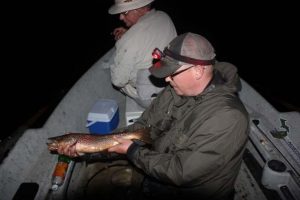 No matter what, the hatch happens in June every year, with some colder rivers extending hatches into the first week of July. An enterprising angler can start fishing brown drakes the first week of June (if anything an even more sublime and frustrating hatch than the Hex) then catch the very first Hex hatches perhaps as early as June 8-10. Then it peaks between June 15-21 with colder and more northerly stretches of stream continuing into the first week of July. There is a considerable dead spot in all fishing in Michigan from about July 1-10 as fish recover from gorging on the massive amounts of flies, after which the afternoon terrestrial bite and nighttime mousing will take off.
No matter what, the hatch happens in June every year, with some colder rivers extending hatches into the first week of July. An enterprising angler can start fishing brown drakes the first week of June (if anything an even more sublime and frustrating hatch than the Hex) then catch the very first Hex hatches perhaps as early as June 8-10. Then it peaks between June 15-21 with colder and more northerly stretches of stream continuing into the first week of July. There is a considerable dead spot in all fishing in Michigan from about July 1-10 as fish recover from gorging on the massive amounts of flies, after which the afternoon terrestrial bite and nighttime mousing will take off.
Weather
Weather is a key factor. I’d say the perfect Hex weather would be clear to partly cloudy, 78-82 degrees F during the day, with enough humidity to retain the heat at night. Mid 60-70’s at night is ideal for the bugs to fly. Calm conditions, nighttime mist or an approaching front are all conducive to epic hatches. Violent weather and cold fronts are not. Keep in mind that the hatches will happen regardless, and once the bugs emerge their clock is ticking. They are completely unable to feed themselves as adults, so they absolutely must mate within a couple days of hatching or they’ll die. But a significant cold front can suppress emergence or their mating flight by a day or two. Be ready when the next occurrence of steady weather happens.
Time
If you’re planning a trip for the Hex hatch, give yourself a week. A weekend trip could be entirely wasted by a single cold front. Being a local gave me a huge leg up over visiting anglers. I would simply wait until I saw the big hatches happen on the lakes around me, then fish the rivers a couple days after. The hatches start on the lakes and work their way up the streams as they warm. If you are able, try to keep your travel plans flexible. You’ll want be there between June 8 and July 1, but you’re also looking for a weather window conducive to the fishing. If you can steer your trip around cold fronts and violent weather so much the better. If you can spare a full week this is your best chance to ensure you’re not blanked by fickle bugs, high water or bad weather.
Location Location Location
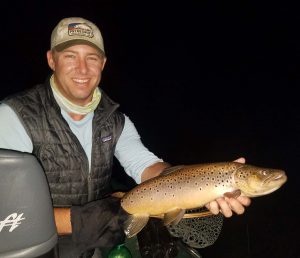 Not all Hex streams are the same, and they don’t all start at the same time. The Au Sable is one giant jigsaw puzzle for the fly angler. Some parts can start as early as June 8; others won’t start for another ten days. It’s such a large system that consists of slower and faster sections with infusions of cold tributary and spring water, that warmer slow upper sections can go off before colder, faster lower sections. Some tributaries like the North and South Branches are extensive trout streams in themselves with their own timing and vagaries. The Manistee tends to run a little later than the Au Sable. How do you parse all this out?
Not all Hex streams are the same, and they don’t all start at the same time. The Au Sable is one giant jigsaw puzzle for the fly angler. Some parts can start as early as June 8; others won’t start for another ten days. It’s such a large system that consists of slower and faster sections with infusions of cold tributary and spring water, that warmer slow upper sections can go off before colder, faster lower sections. Some tributaries like the North and South Branches are extensive trout streams in themselves with their own timing and vagaries. The Manistee tends to run a little later than the Au Sable. How do you parse all this out?
Hire a guide for a week if you can, or for at least enough nights that he’ll give you suggestions on where to wade when you’re not with him. In my experience Michigan guides are second to none for putting their clients on fish. An experienced guide will understand the timing of the various stretches and the factors that make the hatch go off or not. Many are even willing to hop streams if one is going off when another has gone cold.
Hang out and spend money at fly shops like Gates Au Sable Lodge or Old Au Sable Fly Shop in Grayling. These establishments are on the water, they have guides and sell the flies you need. They are a great place to exchange stories and get the scuddlebutt on what’s happening where. They are in the business of helping you be successful, but they are a business so show some appreciation in the form of dollars spent. Also, this is a night hatch which means an afternoon or evening spent at the fly shop is not fishing time wasted. Very little happens on trout streams during daylight hours when the Hex are hatching. Use the daytime to catch up on sleep, prep your gear, but especially to gather intel, study maps, and ask questions at the fly shop to determine where you should fish that night. Be willing to move around or even drive an hour or two to hop streams or sections. We do it all the time.
Sleep When You’re Dead
You’ll see a few flies in the waning light, and may even see a rise or two, but typically the hatch does not even begin until it is pitch black. Suddenly you flick on a light, point it up into the sky and see a river of insects flying upstream starting around 11 pm if its fully dark. They may not fly until midnight or even 1 am. Do NOT do what I’ve seen many anglers do, which is give up when nothing has happened by 11 pm. On any given night during the Hex hatch plan on being out there until 2-3 am. I can’t tell you the number of times I’ve gotten off the water as the sun rose (then drove straight to work). The exception is when severe weather or cold makes it plain that a hatch won’t happen that night. If it’s below 60 degrees air temp at night, the chance of a hatch going off decreases dramatically. But barring that, plan on being out there from 10 at night until at least 3 am each morning. Sleep from the wee hours until noon if you can, then prep your gear again, go to the fly shop or make your phone calls to try to get the scuddlebutt and reformulate a plan.
Fish the Upside of the Hatch and the Backside of the Spinner Fall.
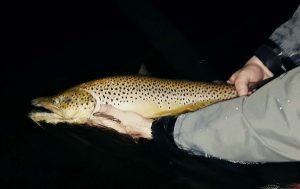 The fish always seem to know and anticipate the Hex hatch before it gets started. Fishing the upside means fishing those first few days when the hatch is building before the main blowout hatches happen. When those first few bugs come off the water and a few early spinners fall can be some of the best fishing of the season as big browns come out searching for those first big bugs. It’s even possible to target big fish feeding before dark. This can be your chance to catch a big fish at dusk and then get some sleep- The fish are out hunting those bugs and you’ll see a smattering of them flying before dark, but the main spinner fall doesn’t happen, so there’s no sense staying out all night. This tends to overlap with the brown drakes which hatch first, so be prepared for those as well.
The fish always seem to know and anticipate the Hex hatch before it gets started. Fishing the upside means fishing those first few days when the hatch is building before the main blowout hatches happen. When those first few bugs come off the water and a few early spinners fall can be some of the best fishing of the season as big browns come out searching for those first big bugs. It’s even possible to target big fish feeding before dark. This can be your chance to catch a big fish at dusk and then get some sleep- The fish are out hunting those bugs and you’ll see a smattering of them flying before dark, but the main spinner fall doesn’t happen, so there’s no sense staying out all night. This tends to overlap with the brown drakes which hatch first, so be prepared for those as well.
Conversely, once the main hatch happens you want to fish the “backside” of each spinner fall. On the first night that the main hatch happens the spinners will leave the trees and bankside brush after dark and fly up the river to mate. Once they spin (fall) every fish in the river will go nuts gorging on flies. If there are good fish rising around you by all means cast to them, but don’t get discouraged if they can’t pick your fly out of the masses and rafts of floating bugs on the water. There will be a “push” of bugs down the river as this spinner fall makes its way downstream, but within a couple hours it will start to taper off. The smaller fish will gorge themselves and go dormant. But bigger fish, the giants, will continue to feed all night picking off the steady trickle of remaining bugs coming down the river. This is the fishing my friends and I are normally targeting, and often it doesn’t happen until after 1 am. The only fish left feeding will be very large and continue to feed all night. Now you can start to slip downstream in your drift boat as silently as possible so that you can hear the telltale slurp and sucking sounds of large feeding trout. It is this time period and not the main spinner fall that is most productive for experienced anglers. By all means fish both, but it’s that slower trickle of flies afterward that allows you to hunt big fish.
Beat the Crowds
This is a tough one, and stretches that I used to fish with some elbow room to spare have gotten crowded. Expect to find cars at every access and a line at the boat ramp. If you’re wading, go to a walk in access and post up on a spot. Most boaters will steer clear of you. Do as much daytime scouting as you can and if a spot is overcrowded move on to your next spot. Get there early, bring a sandwich and a beverage and hang out for a few hours. Socialize with the other anglers. I like to rig up and cast to the spots I think fish will rise in, learn the distance and figure out my mends so I can do it by rote in the dark.
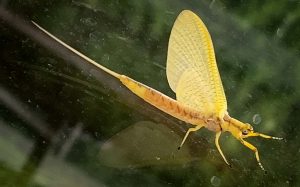 Having a watercraft (Au Sable boat, canoe, drift boat, raft etc.) increases your options a lot, but you may still find yourself in a long line of boats. One year fishing with Ethan Winchester of Boyne Outfitters and his friend Jon Odykirk, we bit off a very long stretch of the Au Sable that is not flies only and is an 8 hour minimum float. We launched early, floated 2-3 hours before dark to get to the stretch Jon had in mind, then posted up and waited for the dark and the hatch. We only saw two other boats all night, and yes, the sun was up when we took out, but we all caught big fish and missed or screwed up opportunities on bigger fish. If you find yourself in a long line of boats do not despair. I can’t tell you the number of times a boat in front of us has pulled anchor only for a large fish to start feeding right after they left and we’ve dropped down and caught it. Big fish tend to feed for 10-15 minutes at a time, then rest for a few minutes before feeding again. Many times we’ve pulled anchor only to have a fish start feeding immediately where we were. Sometimes we’ve rowed back up and caught it.
Having a watercraft (Au Sable boat, canoe, drift boat, raft etc.) increases your options a lot, but you may still find yourself in a long line of boats. One year fishing with Ethan Winchester of Boyne Outfitters and his friend Jon Odykirk, we bit off a very long stretch of the Au Sable that is not flies only and is an 8 hour minimum float. We launched early, floated 2-3 hours before dark to get to the stretch Jon had in mind, then posted up and waited for the dark and the hatch. We only saw two other boats all night, and yes, the sun was up when we took out, but we all caught big fish and missed or screwed up opportunities on bigger fish. If you find yourself in a long line of boats do not despair. I can’t tell you the number of times a boat in front of us has pulled anchor only for a large fish to start feeding right after they left and we’ve dropped down and caught it. Big fish tend to feed for 10-15 minutes at a time, then rest for a few minutes before feeding again. Many times we’ve pulled anchor only to have a fish start feeding immediately where we were. Sometimes we’ve rowed back up and caught it.
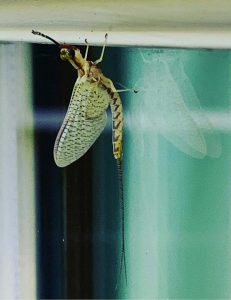 Going to a smaller stream is no guarantee of fewer people. One tiny stream with no boat access near where I lived would have 30-40 cars at the access some years. It was silly. But the popularity of spots waxes and wanes. All it takes is 40 guys showing up on a night that no bugs appear, and the next year there will be fewer cars. The best ways I’ve found to beat crowds is to go early and post up on a spot wading or floating, be patient, fish a long stretch that others may not want to get stuck on, fish late (you’d be surprised how many anglers quit by midnight to one am). Fishing a long float can be a two-edged sword and I recommend against it if the weather and outlook isn’t perfect. I’ve been stuck on these long floats when no bugs hatched and no fish fed, having to push for hours downstream in the dark to get out, and trust me it’s no fun. The flip side is having almost an entire stream to yourself with lots of bugs and big fish rising on every stretch, with no one in sight for miles. If you’re wading, being willing to hike in makes a big difference. Even a few hundred yards weeds out a lot of anglers. Most boats will respect wading anglers and leave that patch of water to you (as they should). The banks of the Pere Marquette, Manistee and Au Sable are littered with public access. You can use apps like OnX Maps to find other pieces of public land and avoid private, but as long as you stay in the water Michigan law allows you to fish water that isn’t surrounded by public land.
Going to a smaller stream is no guarantee of fewer people. One tiny stream with no boat access near where I lived would have 30-40 cars at the access some years. It was silly. But the popularity of spots waxes and wanes. All it takes is 40 guys showing up on a night that no bugs appear, and the next year there will be fewer cars. The best ways I’ve found to beat crowds is to go early and post up on a spot wading or floating, be patient, fish a long stretch that others may not want to get stuck on, fish late (you’d be surprised how many anglers quit by midnight to one am). Fishing a long float can be a two-edged sword and I recommend against it if the weather and outlook isn’t perfect. I’ve been stuck on these long floats when no bugs hatched and no fish fed, having to push for hours downstream in the dark to get out, and trust me it’s no fun. The flip side is having almost an entire stream to yourself with lots of bugs and big fish rising on every stretch, with no one in sight for miles. If you’re wading, being willing to hike in makes a big difference. Even a few hundred yards weeds out a lot of anglers. Most boats will respect wading anglers and leave that patch of water to you (as they should). The banks of the Pere Marquette, Manistee and Au Sable are littered with public access. You can use apps like OnX Maps to find other pieces of public land and avoid private, but as long as you stay in the water Michigan law allows you to fish water that isn’t surrounded by public land.
If I can boil this down for you, go at the right time (mid-June), allow enough time or pick the right weather window, be willing to move around, stay out late, fish those all-night feeders, and adapt to the crowds. If the fishing is tough, remember that’s why you came to fly fishing. If you want easy, go back to fishing worms for bluegills. The reward is catching big fish that you earned through hard work, lost sleep, and blood loss to the mosquitoes.
Did I mention the mosquitoes?
Jason writes the fine blog Fontinalis Rising
Jason Tucker
Gink & Gasoline www.ginkandgasoline.com hookups@ginkandgasoline.com Sign Up For Our Weekly Newsletter!
The Hex hatch is also a great time to target Carp on Lake Erie. I have caught some absolute pigs that have just finished the spawn and will chase down flies (during the day) that resemble Hex emergers going to the surface. Bring a 9wt for sure.
Wow!! What a great article! Awesome guide to fishing the Hex Hatch for a a newbie like me without giving away actual spots on the rivers. Thanks for all the help.
You can’t imagine it until you experience it. The fish just boil around you, but it’s a narrow window of time. The hatch I experienced on the Manistee years ago started less than an hour before dark. Last year we went to the Pere Marquette and it didn’t start until dark and it was all blind casting. This is where I first learned to not match the hatch. I was 14 and the first night we couldn’t catch a fish with artificial mayflies. That night I tied up some large white wooly moths and the next night slaughtered the fish. My theory is that there are so many bugs on the water that one that stands out gets their attention.